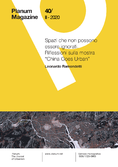local plans call for papers news periodic news competition maps innovation public policies identity planning ecology parks urbanism land use inclusive processes urban regeneration premio gubbio 2018 social practices agriculture central places strategic planning safety & security Community premio tesi di laurea tools and techniques
Spazi che non possono
essere ignorati
Riflessioni sulla mostra
“China Goes Urban”
Leonardo Ramondetti
Leonardo Ramondetti
Spazi che non possono essere ignorati.
Riflessioni sulla mostra “China Goes Urban”
Articolo pubblicato su | This article is published in:
Planum. The Journal of Urbanism no. 40, vol. II/2020
www.planum.net | ISSN 1723-0993
This article discusses the main issues raised by the exhibition China Goes Urban. The city to come, opened on October 15th 2020 at MAO – Museum of Oriental Art in Turin. The exhibition invites us to reflect on the transformations affecting the contemporary city, and the importance of investigate these in contexts where their features are more evident and radical, such as today’s China. It is a well-known fact that since the past two decades the Chinese city has undergone radical changes related to great processes of infrastructuralisation, migration, enormous urban growth and so on. Even if these phenomena have drawn the attention of many scholars in different fields of study, a general consensus in considering the Chinese space as a ‘different’ and ‘exceptional’ space is still dominant in most of literature. Differently, the exhibition aims to document and investigate the Chinese urbanization in order to reposition this subject into a wider and more ordinary framework regarding urbanization processes, and, in so doing, making it debateable. In order to perform this operation the objective of the exhibition is twofold: on the one hand a step-by-step de-contextualisation of the spaces observed, on the other a progressive familiarisation with the inquired subject. By adopting this strategy the exhibition turns the Chinese city into ‘a lens’ through which it is possible to investigate the world around us; an helpful viewpoint to identify and discuss topics that today are extremely relevant. In particular the exhibition puts the spotlight on four main issues: ‘urbanization’, ‘urban fragments’, ‘infrastructures’, ‘urban-rural relations’. Based on these topics, the exhibition poses questions and opens up to issues that overcome the specificities of Chinese city. In doing this, it highlights the necessity of performing increasingly precise empirical research able to move past those culturalist approaches that still characterize most of studies on Chinese urbanization.

Leonardo Ramondetti is an architect, Ph.D. in Urban and Regional Development at Politecnico di Torino and Università di Torino. He is a post-doc researcher in urban studies currently working at Politecnico di Torino in the research Rescaling the Belt and Road Initiative: urbanization processes, innovation patterns and global investments in urban China (2020-2023). His recent work includes contributions in the research CeNTO (Chinese New Town) (2016-2019), and the publication The City after Chinese New Towns (M. Bonino et al., 2019) edited by Birkhäuser





Planum
The Journal of Urbanism
ISSN 1723-0993
owned by
Istituto Nazionale di Urbanistica
published by
Planum Association
ISSN 1723-0993 | Registered at Court of Rome 4/12/2001, num. 514/2001
Web site realized by ChannelWeb & Planum Association | Powered by BEdita 3





